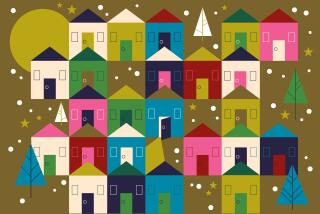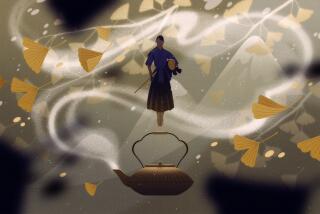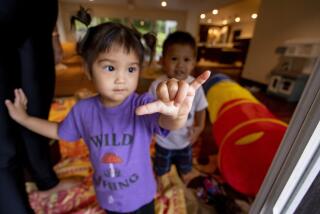Shinto Sect Starts Year With a Clean Consciousness
On the first day of the new year, the Rev. Alfred Tsuyuki was not nursing a hangover, cheering on college football teams or watching the dazzling array of floats in the Rose Parade like many of his fellow Southern Californians.
Instead, he was purifying his flock at Konko Church of Los Angeles, using elements of an ancient Japanese ritual aimed at clearing out the negative energies of the past.
Dressed in white silk robes and a black pointed hat, Tsuyuki held aloft a large wooden stick topped with white paper streamers before the East Los Angeles congregation of about 75 people. As he waved the wand three times, he chanted, “May each and every one of your discomforts and diseases be dispelled to the great universe of the Principle Parent” -- his tradition’s term for the unseen laws of the universe.
Then the congregation recited purification prayers in English and Japanese and took sips of sacred rice wine.
The ritual, which is rooted in Japan’s indigenous spiritual tradition of Shinto, is “a symbolic purification of your heart to begin the new year with a clean slate,” said Tsuyuki, a Los Angeles native who sports a salt-and-pepper ponytail beneath his ceremonial garb.
Although New Year’s Day has become a secular holiday for many Americans, it has long been associated with spiritual cleansing and renewal in many traditions. Even in the West, New Year’s Eve noisemakers and fireworks once were used as tools to banish evil spirits.
Many Jews purify themselves through ritual immersion in the waters of the mikvah bath, particularly before the Jewish New Year. According to Rabbi Yitzchok Adlerstein, a professor of Jewish law at Loyola Law School, immersion in the mikvah symbolizes reentry into the amniotic fluid of the womb.
“The notion is that no matter where I am or what I may have done, you can always begin anew and return to the natural purity of the soul,” Adlerstein said.
He said, however, that the chief spiritual cleansing before the Jewish New Year, which is observed in autumn, is produced through introspection and reflection. Serious students study special texts or tapes on repentance during the month before the Jewish New Year, he said.
Purification is also associated with water in Hinduism, said Lina Gupta, chairwoman of Glendale Community College’s philosophy department. On the Hindu New Year, which is celebrated at different times in different parts of India, some people immerse themselves in the Ganges River, the greatest of India’s sacred rivers, which Hindus regard as a goddess. For those unable to make the trek, many sprinkle Ganges water throughout their homes after a thorough cleaning, said Gupta, who researches Hinduism.
“Even one drop of Ganges water symbolically cleanses everything,” said Gupta, adding that many Hindus keep a bottle of Ganges water in their homes.
New Year’s Day was declared a holy day in the Christian Church more than 1,500 years ago, but no special purification rituals are performed. Originally observed as a feast day commemorating Jesus’ circumcision, the day is now dedicated to Mary as the mother of God in the Roman Catholic Church. In the Los Angeles Archdiocese, New Year’s Day was removed from the calendar as a holy day of obligation requiring attendance at Mass a few years ago.
According to Father George O’Brien of Good Shepherd Church in Beverly Hills, the most intense time of spiritual cleansing is not New Year’s Day but the 40-day season of Lent before Easter, when Christians may fast, abstain from meat or undergo other spiritual disciplines.
Other New Year’s practices span the globe, including Cambodian altars to welcome the New Year Spirit, Chinese firecrackers to ward off evil spirits and Scottish fire ceremonies to purify the surroundings.
At Konko Church, a small white building sandwiched between a Mexican restaurant and a check-cashing business on 1st Street, preparations for New Year’s Day took place throughout December. On one Sunday, several members showed up at 7 a.m. to give the church a thorough cleaning -- hand-washing each chair individually, mopping and waxing the floors, polishing the windows.
On the last Sunday of December, Konko members made rice cakes in an ancient Japanese custom called mochitsuki.
Konko member Guy Urata said making mochi, or rice cakes, has traditionally been a spiritual act because the Shinto tradition regards each grain of rice as a human soul; rice cakes therefore represent millions of souls.
On New Year’s Day, flattened rice cakes stacked atop each other are laid on a piece of white paper for purity and offered to the deities, along with fruit, vegetables, rice wine and other gifts. Many Japanese also eat rice cakes on New Year’s Day as a symbol of strength.
Today, the mochitsuki has lost most of its spiritual meaning and is seen as a cultural ritual practiced by Japanese of any religion as a way to bring a community together. Konko Church is one of the few places to retain the ritual’s original Shinto roots.
The church is the only Shinto-related religious organization in Southern California. Unlike Buddhists, who sent missionary monks from Japan to establish temples in the United States, Shinto leaders have not generally tried to propagate their faith abroad. The tradition, Tsuyuki said, is less a religion than a way of life that leaders believed could best be experienced in Japan.
Shinto followers believe that kami, or noble and sacred spirits, exist everywhere, including in earthly forms ranging from humans to forests to waterfalls. There are communal rituals and festivals to thank the deities for prosperity and invoke their protection against ill fortune. But the tradition has no well-developed theology, which makes it difficult to convey to others, Tsuyuki said.
The ideal of purity, however, is a central element in Shinto and his own offshoot church. Founded in the mid-19th century by a Japanese farmer known today as Ikigami Konko Daijin, the church was established in Los Angeles in 1930 and now has branches in 10 cities on the West Coast and in Canada. Key concepts include the importance of a pure and grateful heart and the interdependence between kami and humans.
Norman Arikawa, a Los Angeles port official, says Konko is a way to maintain ties to Japanese culture in the face of rapid assimilation. Aya Fujikawa says she goes to the church to give thanks for her good health at age 81.
And Don Cooper, a Los Angeles contractor, says the church has offered lasting friendships and a spiritual connection to his deceased mother, a Japanese native.
On New Year’s Day, they and others packed the small church to cleanse their hearts and start anew.
“To me, the purification is symbolic of change: to release all tensions of ‘Hey, that guy dented my car or took my parking spot,’ ” Cooper said. “Just let it go. Keep yourself cleaned out of all that negative energy and just let it go.”



